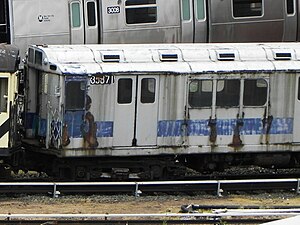Loading AI tools
Retired class of New York City Subway car From Wikipedia, the free encyclopedia
The R14 was a New York City Subway car model built by the American Car and Foundry Company in 1949. The cars were a "follow-up" or supplemental stock for the A Division's R12s and look exactly the same, differing only in floor patterns. A total of 150 cars were built, arranged as single units. Two versions were manufactured: Westinghouse (WH)-powered cars and General Electric (GE)-powered cars.
| R14 | |
|---|---|
 R14 car 5871 (renumbered to 35871) at the 207th Street Yard, awaiting cosmetic restoration | |
| In service | 1949–1984 |
| Manufacturer | American Car and Foundry Company |
| Built at | Berwick, Pennsylvania, USA |
| Constructed | 1949 |
| Entered service | September 1949 |
| Number built | 150 |
| Number in service | (1 in work service) |
| Number preserved | 1 |
| Number scrapped | 148 |
| Successor | R62 |
| Formation | Single units |
| Fleet numbers | 5803–5877 (General Electric) 5878–5952 (Westinghouse) |
| Capacity | 44 (seated) |
| Operators | NYC Board of Transportation New York City Subway |
| Specifications | |
| Car body construction | LAHT Carbon steel |
| Car length | 51 ft (15.54 m) |
| Width | 8 ft 9.5 in (2,680 mm) |
| Height | 11 ft (3,353 mm) |
| Platform height | 3.76 ft (1.15 m) |
| Doors | 6 sets of 50 inch wide side doors per car |
| Maximum speed | 55 mph (89 km/h) |
| Weight | 73,100 lb (33,158 kg) |
| Traction system | Westinghouse XM-179 or General Electric 17KC76A1 |
| Traction motors | Westinghouse 1447C or General Electric 1240A3 |
| Power output | 100 hp (75 kW) |
| Electric system(s) | 600 V DC third rail |
| Current collector(s) | Contact shoe |
| Braking system(s) | WABCO E2 "SMEE" Braking System, A.S.F. simplex unit cylinder clasp (tread) brake |
| Safety system(s) | Tripcock |
| Track gauge | 4 ft 8+1⁄2 in (1,435 mm) standard gauge |
The first R14s entered service in September 1949; the fleet initially ran on the IRT Flushing Line until the R33S and R36 World's Fair fleets were delivered in the 1960s. The R14s were replaced by the R62s in the 1980s, and the final train of R14s ran on December 10, 1984. One R14 car was saved for the New York Transit Museum, while another was saved for work service, and the rest were scrapped.
The R14s were numbered 5803–5952. They were the last cars built with outside door operating apparatus or controls.
While the R14s ran in solid consists on the Flushing line, the cars never did so on the mainlines; they were always intermixed in trains of newer cars and were never placed at the conductor's location.
There were two versions of the R14: General Electric-powered cars (5803–5877) and Westinghouse Electric-powered cars (5878–5952).
Some cars of note:
Delivery of the cars began in August 1949.[1] The first R14s entered service on the 7 (IRT Flushing Line) in September 1949.[2] All 150 cars were delivered by January 1950.[3]
The R14s ran on the Flushing Line until the arrival of the R33Ss and R36 World's Fairs in late 1963–early 1964. The R14s were then transferred to operate on other A-division routes before being retired and replaced by the R62s in the mid-1980s.
Cars 5803–5806 were briefly assigned to 3rd Ave. el service in the Bronx to augment the fleet of the G.E. R12s. When the 3rd Ave. el service ended in April 1973, the 4 cars were returned to main line service.
The last R14 ran on December 10, 1984. All but two cars have since been taken off property to be scrapped; several cars lasted as training vehicles or work cars for many years. For example, eleven R14s were converted into R71 rider cars after retirement, but were ultimately replaced with R161s (R33s converted into rider cars) and subsequently reefed in 2009.[4]
Two cars were retained for various purposes throughout the New York City Subway system, including:
Seamless Wikipedia browsing. On steroids.
Every time you click a link to Wikipedia, Wiktionary or Wikiquote in your browser's search results, it will show the modern Wikiwand interface.
Wikiwand extension is a five stars, simple, with minimum permission required to keep your browsing private, safe and transparent.